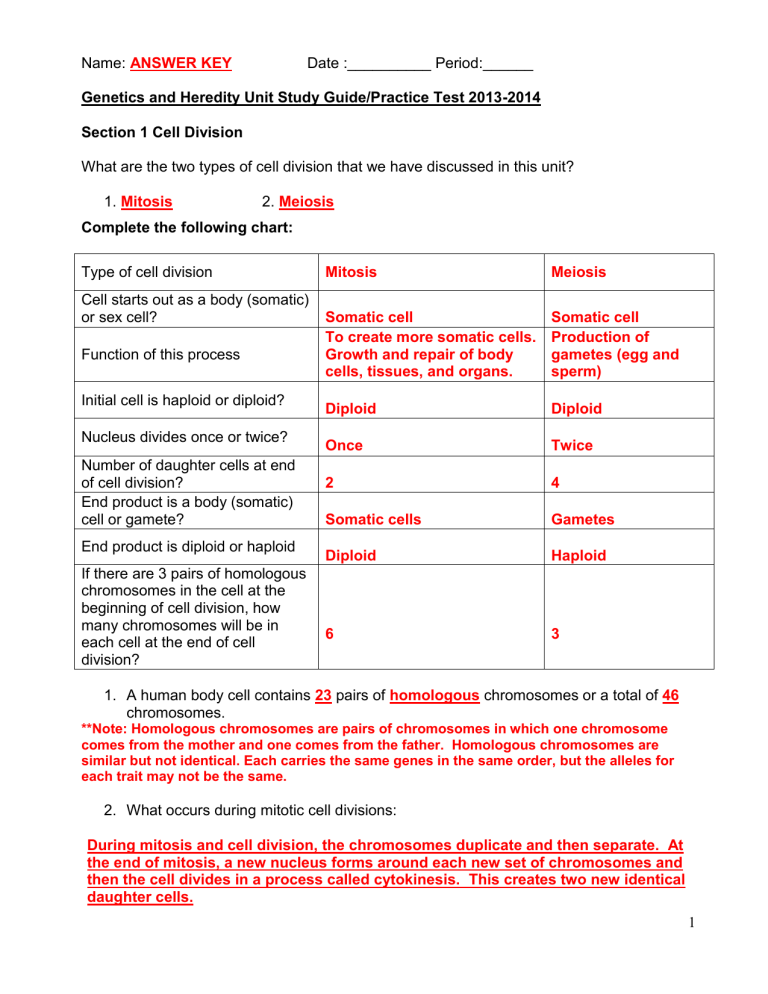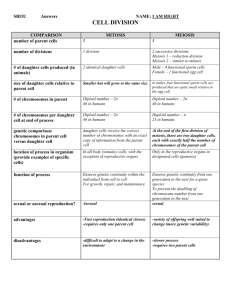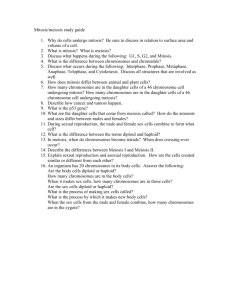Genetics & Heredity Study Guide: Mitosis, Meiosis, DNA

Name: ANSWER KEY Date :__________ Period:______
Genetics and Heredity Unit Study Guide/Practice Test 2013-2014
Section 1 Cell Division
What are the two types of cell division that we have discussed in this unit?
1. Mitosis 2. Meiosis
Complete the following chart:
Type of cell division Mitosis Meiosis
Cell starts out as a body (somatic) or sex cell?
Function of this process
Initial cell is haploid or diploid?
Nucleus divides once or twice?
Somatic cell
To create more somatic cells.
Growth and repair of body cells, tissues, and organs.
Diploid
Once
Somatic cell
Production of gametes (egg and sperm)
Diploid
Twice
Number of daughter cells at end of cell division?
End product is a body (somatic) cell or gamete?
2
Somatic cells
4
Gametes
End product is diploid or haploid
Diploid Haploid
If there are 3 pairs of homologous chromosomes in the cell at the beginning of cell division, how many chromosomes will be in each cell at the end of cell division?
6 3
1. A human body cell contains 23 pairs of homologous chromosomes or a total of 46 chromosomes.
**Note: Homologous chromosomes are pairs of chromosomes in which one chromosome comes from the mother and one comes from the father. Homologous chromosomes are similar but not identical. Each carries the same genes in the same order, but the alleles for each trait may not be the same.
2. What occurs during mitotic cell divisions:
During mitosis and cell division, the chromosomes duplicate and then separate. At the end of mitosis, a new nucleus forms around each new set of chromosomes and then the cell divides in a process called cytokinesis. This creates two new identical daughter cells.
1
Practice Problem for Mitosis and Meiosis
Scientists can look at the results of mitosis and meiosis in fly cells. Flies have 4 chromosomes .
1. Draw a picture showing mitosis in fly cells . Include how many daughter cells are produced, and how many chromosomes are in each daughter cell.
Diagram should indicate 4 chromosomes (diploid) in the first cell. Next, chromosomes duplicate. After a series of steps, the nucleus and cell divide into two identical diploid daughter cells.
2. How many daughter cells are produced in mitosis?
Two daughter cells are produced through mitosis and cell division
2
3. How many chromosomes are in each of the daughter cells as a result of mitosis?
Four chromosomes are in each of the daughter cells after mitosis and cell division
4. Draw a picture showing meiosis in fly cells. Include how many daughter cells are produced, and how many chromosomes are in each daughter cell.
Diagram should indicate 4 chromosomes (diploid) in the first cell. Next, chromosomes duplicate (to 8). Then, the nucleus and cell divide into two identical diploid daughter cells with 4 each. Finally, the two cells divide again to create 4 identical haploid daughter cells (with 2 chromosomes each)
5. How many daughter cells are produced in meiosis?
Four daughter cells are produced through meiosis.
6. How many chromosomes are in each daughter cell as a result of meiosis?
Two chromosomes are in each of the daughter cells after meiosis
3
Sexual Reproduction:
1. Which type of reproduction, sexual or asexual creates diversity in a population? Why?
Sexual reproduction creates diversity in a population because each offspring receives 50% of its DNA from each parent and has a mixture of traits. As organisms reproduce, there is more diversity as a result of greater mixing of DNA.
2. An egg is fertilized by a sperm, the end result is called a zygote or fertilized egg.
3. Describe the differences between haploid cells and diploid cells:
Haploid cells have half the number of chromosomes as a diploid cell. A diploid cell has 2 complete sets of chromosome.
Mendelian Inheritance
1. Mendel, an Austrian monk who lived in the 19 th
century, studied inheritance. He recognized that physical traits and characteristics can be inherited but they can also be influenced by the environment in which an organism lives.
2. The genotype is the genetic combination of alleles for a specific trait.
3. An (A) allele is one form of a gene.
4. Organisms that are purebred are also known as homozygous .
5. Organisms with one recessive allele and one dominant allele
are said to be heterozygous .
Punnett Square Practice:
6. Complete the Punnett Square which shows the genotype for triangle nose shape.
Triangle shape is the dominant trait.
7. What are the phenotypes of the parents?
Parent 1 (on top) has a triangle nose because they are homozygous dominant.
Parent 2 (on side) does not have a triangle nose because they are homozygous recessive. Any other nose shape would be an acceptable answer here!
8. What is the probability that an offspring will have a triangle nose? 4/4 =100 %
4
Genes and DNA
1. DNA is a molecule that contains the instructions or blueprints that direct the development of an organism.
2. Chromosomes are actually strands of DNA wrapped around protein; the DNA is made of sections called genes .
3. Genes are the code for the production of specific traits (proteins is also acceptable)
4. Genes are made up of nucleotides. The components of a nucleotide are a
___ phosphate ___, a ___ sugar _____ and a ____ base ___.
5. There are four types of bases in DNA. These bases are often abbreviated by using the first letter of the name. A, C, T, and G. These include:
Adenine which pairs with Thymine
Cytosine which pairs with Guanine
6. The genome of an organism has 20 % guanine. What percent of the genome will be
Cytosine: 20%
Adenine : 30%
Thymine: 30%
*Note: If 20% is guanine, then 20% must be cytosine. Remember that C and G pair up and must be equal. That means that 60% must be split evenly between adenine and thymine.
7. Complete the following diagram by filling in the blanks from the list of vocabulary: a. Chromosome b. Gene c. DNA d. Nucleus e. Cell
5
Gender Determination:
1. The gender of a human being is determined by the 23 rd
pair of chromosomes. Create a
Punnett square to demonstrate why there is a 50% probability that each child born will be male or female. Use the XX and XY genotypes in the Punnett Square.
X Y
X XX XY
X XX XY
In this Punnett square, the XX represents the mother and the XY represents the father. The combination provides a 2/4 or 50% probability that each child may be male or female.
2. Label the following karyotypes – male or female
This is female because of the XX chromosome combination on pair # 23
(lower right corner of diagram).
This is male because of the XY chromosome combination on pair # 23
(lower right corner of diagram).
6








